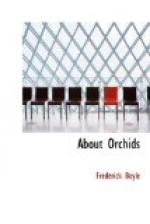It becomes yet stronger by reason of the delightful uncertainty which attends one’s efforts. So far as I have heard or read, no one has yet been able to offer a suggestion of any law which decides the result of combination. In a general way, both parents will be represented in the offspring, but how, to what degree either will dominate, in what parts, colours, or fashions a hybrid will show its mixed lineage, the experienced refuse to conjecture, saving certain easy classes. After choosing parents thoughtfully, with a clear perception of the aim in view, one must “go it blind.” Very often the precise effect desired appears in due time; very often something unlooked for turns up; but nearly always the result is beautiful, whether or no it serve the operator’s purpose. Besides effect, however, there is an utility in hybridization which relates to culture. Thus, for example, the lovely Cypripedium Fairieanum is so difficult to grow that few dealers keep it in their stock; by crossing it with Cyp. barbatum, from Mount Ophir, a rough-and-ready cool species, we get Cyp. vexillarium, which takes after the latter in constitution while retaining much of the beauty of the former. Or again, Cypripedium Sanderianum, from the Malay Archipelago, needs such swampy heat as few even of its fellows appreciate; it has been crossed with Cyp. insigne, which will flourish anywhere, and though the seedlings have not yet bloomed, there is no reasonable doubt that they will prove as useful and beautiful as in the other case. Cypripedium insigne, of the fine varieties, has been employed in a multitude of such instances. There is the striking Cyp. hirsutissimum, with sepals of a nameless green, shaded yellow, studded with spiculae, exquisitely frilled, and tipped, by a contrast almost startling, with pale purple. It is very “hot” in the first place, and, in the second, its appearance would be still more effective if some white could be introduced; present it to Cyp. niveum and confidently expect that the progeny will bear cooler treatment, whilst their “dorsal sepal” will be blanched. So the charming Masdevallia Tovarensis, warm, white and lowly, will take to itself the qualities, in combination, of Mas. bella, tall, cool, and highly coloured red and yellow, as Mr. Cookson has proved; so Phaloenopsis Wightii, delicate of growth and small of flower, will become strong and generous by union with Phal. grandiflora, without losing its dainty tones.
It is worth mention that the first Flora medal offered by the Royal Horticultural Society for a seedling—a hybrid—in open competition was won by Loelia Arnoldiana in 1891; the same variety took the first prize in 1892. It was raised by Messrs. Sander from L. purpurata x Catt. labiata; seed sown 1881, flowered 1891.
And now for the actual process by which these most desirable results, and ten thousand others, may be obtained. I shall not speak upon my own authority, which the universe has no reason to trust. Let us observe the methods practised in the great establishment of Mr. Sander at St. Albans.




